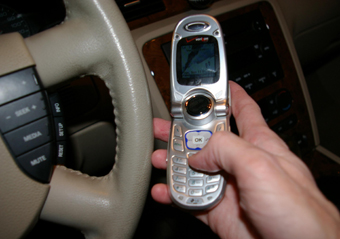
The Dangers of Texting While Driving
| published Sunday, December 15, 2013 |
By Earl H. Perkins, Thursday Review Associate Editor
Thousands of people in this country will whine about their rights with the introduction of laws banning texting while driving. Well, I've just about had enough of the griping.
I've seen a massive number of drivers doing all kinds of dangerous and sometimes unmentionable things while they were driving. Texting just happens to be the worst of those distractions to come along recently. I’ve seen people swerving off the road, I’ve witnessed people almost hitting other vehicles, and I have seen drivers just plain ignoring the road.
Who knows if drivers will quit texting and driving, but the statistics certainly suggest they ought to stop. The National Safety Council estimates that there is an accident every 30 seconds in which the use of a cell phone or handheld device was the cause. At the time of this writing, the NSC’s total for texting-related crashes in 2013 exceeds 986,000 nationally.
In New York State, where law enforcement officials estimate that nearly 10 percent of reported auto accidents involve some form of cell phone distraction behind the wheel, political pressures forced elected leaders to get aggressive. In July Governor Andrew Cuomo signed a statewide law which imposes stricter, harsher penalties on texting behind the wheel, including punishments up to—and including—six month revocations of all driving privileges. The new law received bipartisan support and went into effect immediately.
Last year, in Florida, of 256,443 crashes statewide, almost 5,000 involved drivers who were texting or using some other electronic communication device, according to the Federal Motor Carrier Safety Administration.
Nationally, those killed in distraction-affected crashes decreased slightly from 3,360 in 2011 to 3,328 in 2012, according to the National Highway Traffic Safety Administration website. Approximately 421,000 people were injured in motor vehicle crashes involving a distracted driver -- a nine-percent increase from the estimated 387,000 people injured in 2011. By December 2012, 171.3 billion text messages were sent in the United States every month. This statistical base includes Puerto Rico, Guam and other territories.
Eleven percent of drivers younger than 20 who were involved in fatal crashes were reported as distracted at the time. This age group contains the largest proportion of distracted drivers. For 15- to 19-year-old drivers involved in fatal crashes, twenty-one percent were distracted by cell-phone usage. During daylight hours in this country, about 660,000 drivers are using cell phones or electronic devices while driving, a number which has remained about the same since 2010.
You triple your chance of being in a vehicular accident when you engage in visual-manual subtasks, which includes reaching for a phone, dialing and texting. When you send or receive a text while driving, you glance away from the road for an average of 4.6 seconds. This amount of time would allow you to drive the length of a football field at 55 mph-blind. Furthermore, contrary to what many people believe, hands-free devices do not substantially improve your chances of avoiding an accident. Several major studies have shown that even in hands-free mode, cell phone conversations can lead to serious impairment, as well as distracting from the task of driving by reducing the driver’s defensive awareness and reaction time.
It gets worse with much younger drivers. Around one-fourth of teens respond to a text message one or more times every time they drive. And when it comes to having extended, multi-message text conversations while driving, 20 percent of teens and 10 percent of adults admit to doing so.
Florida recently enacted a ban on texting while driving, and the violation comes with a $30 fine for the first offense, according to the Tampa Tribune.
"The law is here," said Hillsborough County schools spokeswoman Tanya Arja. "You shouldn't have been doing it in the first place, and now it's illegal."
The state's campaign is entitled "Put It Down," with administrators and public service announcements urging students to sign a pledge that they won't use their phones while driving. Many of the worst offenders are new drivers, so that's where the educational emphasis is being concentrated. Talk-to text devices and texting at red lights are not included in the ban.
There are 41 states that have outlawed texting while driving, and 37 of those made it a primary offense, according to the Governors Highway Safety Association.
"It's important for all students to be aware that this law is in effect," said Melanie Marquez Parra, spokeswoman for the Pinellas County school district. "This is a part we can play to help them be safe."
One group that has had a profound impact in the anti-texting movement surrounded the death of Alex Brown, a 17-year-old high school student who was killed in a Lubbock, Texas, texting-while-driving accident in November, 2009. She rolled her truck and was ejected from the vehicle. She was a senior at Seagraves High School in Wellman, and she'd sent and received more than 10,000 texts on her phone the week she died.
She was involved with FFA, FCA, FTA, Basketball, Cheerleading, OneAct Play, the Leadership Team, the Kairos Prison Ministry and the Drama Ministry with the Youth Group at Calvary Baptist Church. Her parents founded Buckle Up and Stop Texting (BUST), a program to educate youth and adults of the dangers associated with texting and driving. Many of her friends and family signed a pledge to wear their seat belts and not text and drive.
For information about their organization, you can access the website:
Silver Streak Online: Dangers of Texting While Driving.
You can also access a very informative government website with details concerning statistics and data from across the country at: Distraction.gov.
